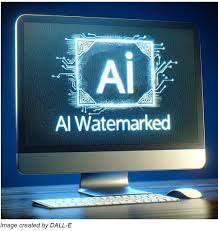Watermarking On AI Generated Content:

ChatGPT-maker OpenAI developed a tool to detect whether its AI (Artificial Intelligence) chatbot has been used to write essays, research papers, or generate photos.
- To address issues concerning the authenticity and ownership of such content, leading technology companies like OpenAI, Meta, Microsoft, Google, and Adobe are developing and implementing watermarking techniques.
- The AI watermarking technique is used to identify what’s AI-generated and what is an original work.
- It is a digital signature that serves as a unique identifier, akin to a fingerprint, allowing for the tracing of the AI model used to create the content back to its origin.
- It provides a reliable method for verifying the authenticity of digital files, crucial in combating deepfake videos, manipulated images, and deceptive media in a digitally-driven world.
- Integrating AI watermarking with blockchain and public key infrastructure ensures that any attempts to alter or manipulate content are detectable, preserving the integrity of digital records.
- By assuring the authenticity of media, AI watermarking helps content creators, distributors, and consumers combat misinformation and counterfeiting, bolstering trust and understanding of content provenance.




